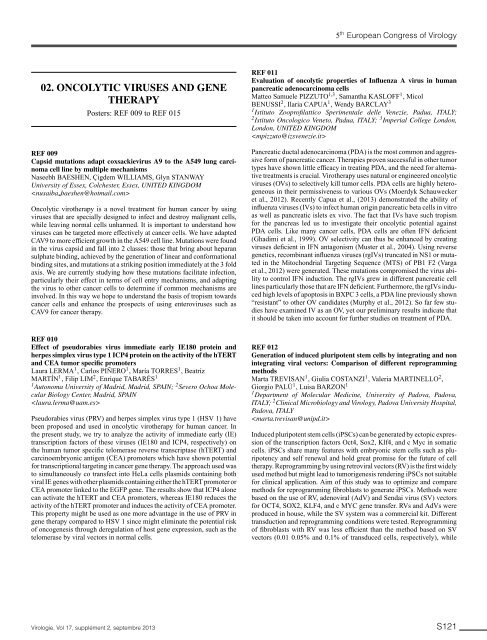rologie i - European Congress of Virology
rologie i - European Congress of Virology
rologie i - European Congress of Virology
You also want an ePaper? Increase the reach of your titles
YUMPU automatically turns print PDFs into web optimized ePapers that Google loves.
5 th <strong>European</strong> <strong>Congress</strong> <strong>of</strong> <strong>Virology</strong>02. ONCOLYTIC VIRUSES AND GENETHERAPYPosters: REF 009 to REF 015REF 009Capsid mutations adapt coxsackievirus A9 to the A549 lung carcinomacell line by multiple mechanismsNaseebh BAESHEN, Çigdem WILLIAMS, Glyn STANWAYUniversity <strong>of</strong> Essex, Colchester, Essex, UNITED KINGDOMOncolytic virotherapy is a novel treatment for human cancer by usingviruses that are specially designed to infect and destroy malignant cells,while leaving normal cells unharmed. It is important to understand howviruses can be targeted more effectively at cancer cells. We have adaptedCAV9 to more efficient growth in the A549 cell line. Mutations were foundin the virus capsid and fall into 2 classes: those that bring about heparansulphate binding, achieved by the generation <strong>of</strong> linear and conformationalbinding sites, and mutations at a striking position immediately at the 3 foldaxis. We are currently studying how these mutations facilitate infection,particularly their effect in terms <strong>of</strong> cell entry mechanisms, and adaptingthe virus to other cancer cells to determine if common mechanisms areinvolved. In this way we hope to understand the basis <strong>of</strong> tropism towardscancer cells and enhance the prospects <strong>of</strong> using enteroviruses such asCAV9 for cancer therapy.REF 011Evaluation <strong>of</strong> oncolytic properties <strong>of</strong> Influenza A virus in humanpancreatic adenocarcinoma cellsMatteo Samuele PIZZUTO 1,3 , Samantha KASLOFF 1 , MicolBENUSSI 2 , Ilaria CAPUA 1 , Wendy BARCLAY 31 Istituto Zoopr<strong>of</strong>ilattico Sperimentale delle Venezie, Padua, ITALY;2 Istituto Oncologico Veneto, Padua, ITALY; 3 Imperial College London,London, UNITED KINGDOMPancreatic ductal adenocarcinoma (PDA) is the most common and aggressiveform <strong>of</strong> pancreatic cancer. Therapies proven successful in other tumortypes have shown little efficacy in treating PDA, and the need for alternativetreatments is crucial. Virotherapy uses natural or engineered oncolyticviruses (OVs) to selectively kill tumor cells. PDA cells are highly heterogeneousin their permissiveness to various OVs (Moerdyk Schauweckeret al., 2012). Recently Capua et al., (2013) demonstrated the ability <strong>of</strong>influenza viruses (IVs) to infect human origin pancreatic beta cells in vitroas well as pancreatic islets ex vivo. The fact that IVs have such tropismfor the pancreas led us to investigate their oncolytic potential againstPDA cells. Like many cancer cells, PDA cells are <strong>of</strong>ten IFN deficient(Ghadimi et al., 1999). OV selectivity can thus be enhanced by creatingviruses deficient in IFN antagonism (Muster et al., 2004). Using reversegenetics, recombinant influenza viruses (rgIVs) truncated in NS1 or mutatedin the Mitochondrial Targeting Sequence (MTS) <strong>of</strong> PB1 F2 (Vargaet al., 2012) were generated. These mutations compromised the virus abilityto control IFN induction. The rgIVs grew in different pancreatic celllines particularly those that are IFN deficient. Furthermore, the rgIVs inducedhigh levels <strong>of</strong> apoptosis in BXPC 3 cells, a PDA line previously shown“resistant” to other OV candidates (Murphy et al., 2012). So far few studieshave examined IV as an OV, yet our preliminary results indicate thatit should be taken into account for further studies on treatment <strong>of</strong> PDA.REF 010Effect <strong>of</strong> pseudorabies virus immediate early IE180 protein andherpes simplex virus type 1 ICP4 protein on the activity <strong>of</strong> the hTERTand CEA tumor specific promotersLaura LERMA 1 , Carlos PIÑERO 1 , María TORRES 1 , BeatrizMARTÍN 1 , Filip LIM 2 , Enrique TABARÉS 11 Autonoma University <strong>of</strong> Madrid, Madrid, SPAIN; 2 Severo Ochoa MolecularBiology Center, Madrid, SPAINPseudorabies virus (PRV) and herpes simplex virus type 1 (HSV 1) havebeen proposed and used in oncolytic virotherapy for human cancer. Inthe present study, we try to analyze the activity <strong>of</strong> immediate early (IE)transcription factors <strong>of</strong> these viruses (IE180 and ICP4, respectively) onthe human tumor specific telomerase reverse transcriptase (hTERT) andcarcinoembryonic antigen (CEA) promoters which have shown potentialfor transcriptional targeting in cancer gene therapy. The approach used wasto simultaneously co transfect into HeLa cells plasmids containing bothviral IE genes with other plasmids containing either the hTERT promoter orCEA promoter linked to the EGFP gene. The results show that ICP4 alonecan activate the hTERT and CEA promoters, whereas IE180 reduces theactivity <strong>of</strong> the hTERT promoter and induces the activity <strong>of</strong> CEA promoter.This property might be used as one more advantage in the use <strong>of</strong> PRV ingene therapy compared to HSV 1 since might eliminate the potential risk<strong>of</strong> oncogenesis through deregulation <strong>of</strong> host gene expression, such as thetelomerase by viral vectors in normal cells.REF 012Generation <strong>of</strong> induced pluripotent stem cells by integrating and nonintegrating viral vectors: Comparison <strong>of</strong> different reprogrammingmethodsMarta TREVISAN 1 , Giulia COSTANZI 1 , Valeria MARTINELLO 2 ,Giorgio PALÙ 1 , Luisa BARZON 11 Department <strong>of</strong> Molecular Medicine, University <strong>of</strong> Padova, Padova,ITALY; 2 Clinical Microbiology and <strong>Virology</strong>, Padova University Hospital,Padova, ITALYInduced pluripotent stem cells (iPSCs) can be generated by ectopic expression<strong>of</strong> the transcription factors Oct4, Sox2, Klf4, and c Myc in somaticcells. iPSCs share many features with embryonic stem cells such as pluripotencyand self renewal and hold great promise for the future <strong>of</strong> celltherapy. Reprogramming by using retroviral vectors (RV) is the first widelyused method but might lead to tumorigenesis rendering iPSCs not suitablefor clinical application. Aim <strong>of</strong> this study was to optimize and comparemethods for reprogramming fibroblasts to generate iPSCs. Methods werebased on the use <strong>of</strong> RV, adenoviral (AdV) and Sendai virus (SV) vectorsfor OCT4, SOX2, KLF4, and c MYC gene transfer. RVs and AdVs wereproduced in house, while the SV system was a commercial kit. Differenttransduction and reprogramming conditions were tested. Reprogramming<strong>of</strong> fibroblasts with RV was less efficient than the method based on SVvectors (0.01 0.05% and 0.1% <strong>of</strong> transduced cells, respectively), whileVi<strong>rologie</strong>, Vol 17, supplément 2, septembre 2013S121


